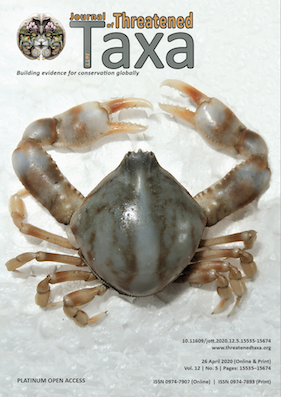Comparative phytosociological assessment of three terrestrial ecosystems of Wayanad Wildlife Sanctuary, Kerala, India
DOI:
https://doi.org/10.11609/jott.4754.12.5.15631-15645Keywords:
Invasive alien species, phytosociology, Simpson Diversity Index, Wayanad Wildlife Sanctuary, Western GhatsAbstract
Phytosociological studies were conducted in three vegetation types in the WS II area of Wayanad Wildlife Sanctuary. In each vegetation type, 85 quadrats (10 x 10 m) were laid to quantify the vegetation. Natural forest showed comparatively higher species richness than plantation and vayal (swamps/low lying grassland). In natural forest 96 plant species were present while it was 70 and 66 respectively in plantation and vayal. Fabaceae was the dominant family in all the three vegetation types. The natural forest was dominated by Chromolaena odorata, followed by Lantana camara, Mimosa pudica, Terminalia elliptica, Glycosmis pentaphylla. In the plantations, Chromolaena odorata, Tectona grandis, Mimosa pudica and Glycosmis pentaphylla showed dominance. The vayal was dominated by Arundinella leptochloa. The second most dominant species in the vayal was Chromolaena odorata. Other dominant species were Kyllinga nemoralis and Sporobolus tenuissimus. Among the three, vayal recorded the highest Simpson Diversity Index. The highest Berger-Parker Dominance Index value in plantation indicates the presence of dominant species. Natural forests recorded highest Margalef Richness Index and the least was in vayal. The highest Pielou’s Wiener Equitability Index in vayal indicated all species are evenly distributed.
References
Battles, J.J., A.J. Shlinsky, R.H. Barrett, R.C. Heald & B.H. Allen-Diaz (2001). The effects of forest management on plant species diversity in a Sierran conifer forest. Forest Ecology and Management 146: 211–222.
Berger, W.H. & F.L. Parker (1970). Diversity of Planktonic Foraminifera in Deep-Sea Sediments. Science 168(3937): 1345–1347.
Chaubey, O.P., R. Prasad & G.P. Mishra (1988). Studies of Teak Plantation and mixed natural forest in Madhya Pradesh. Journal of Tropical Forestry 4: 22–35.
Das, D., B.K. Pramanik & S.K. Mollay (2015). A Model Classical Ecological report on Vegetation dynamics in Gorumara National Park in West Bengal, India. International Journal Pharmacy & Biomedical Research 2(2): 1–14.
GOK [Government of Kerala] (2012). Wayanad Wildlife Sanctuary Management plan [on-line]. Available: http://www.forest.kerala.gov.in/index.php/forest/forestmanagement/management-plans [11 Sept 2012], 230pp.
Hamzaoglu, E. (2006). Phytosociological studies on the steppe communities of East Anatolia. Ekoloji 15(61): 29–55.
Kumar, A., G.M. Bruce & S. Ajai (2006). Tree species diversity and distribution patterns in tropical forests of Garo Hills. Current Science 91: 1370–1381.
Lloyd, M. & R.J. Ghelard (1964). A table for calculating the equitability component of species diversity. Journal of Animal Ecology 33: 217–255.
Margalef, R. (1958). Temporal succession and spatial heterogeneity in phytoplankton, pp. 323–347. In: Buzzati-Traverso (ed.). Perspectives in Marine Biology. University California Press, Berkeley. 621 pp.
Pielou, E.C. (1969). An Introduction to Mathematical Ecology. Wiley-Interscience, New York, 286pp.
Sarkar, A.K. (2015). Phytosociological studies of tree vegetation of Moraghat forest range, India. Asian Journal of Biological Life Science 4(3): 217–220.
Sarkar, A.K. (2016). Ecological Studies of Tree Vegetation of Ramshai Forest Range, Gorumara National Park, India. Research Journal of Biological Sciences 5(7): 53–59.
Simpson, E.H. (1949). Measurement of Diversity. Nature.163: 688.
Rao, S.D., P.P. Murthy & O.A. Kumar (2015). Plant biodiversity and phytosociological studies on tree species diversity of Khammam District, Telangana State, India. Journal of Pharmaceutical Sciences and Research 7(8): 518–522.
Published
Issue
Section
License
Authors own the copyright to the articles published in JoTT. This is indicated explicitly in each publication. The authors grant permission to the publisher Wildlife Information Liaison Development (WILD) Society to publish the article in the Journal of Threatened Taxa. The authors recognize WILD as the original publisher, and to sell hard copies of the Journal and article to any buyer. JoTT is registered under the Creative Commons Attribution 4.0 International License (CC BY), which allows authors to retain copyright ownership. Under this license the authors allow anyone to download, cite, use the data, modify, reprint, copy and distribute provided the authors and source of publication are credited through appropriate citations (e.g., Son et al. (2016). Bats (Mammalia: Chiroptera) of the southeastern Truong Son Mountains, Quang Ngai Province, Vietnam. Journal of Threatened Taxa 8(7): 8953–8969. https://doi.org/10.11609/jott.2785.8.7.8953-8969). Users of the data do not require specific permission from the authors or the publisher.





